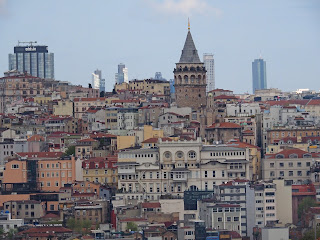We started at the old train station where the Orient Express would finish its run
And went to an old tea room where our guide had brought a full spread of foods that would be typical of a Turkish breakfast - cheeses, olives, savory spreads and a variety of sweet spreads like honey, fruit syrups and honey. The bread is simit which is like a bagel covered with sesame seeds
We visited a small market the emphasized artisanal producers
We snacked on gosleme which is very much like the qutab we had in Azerbaijan - a thin pancake filled with in this case greens
Then we started to walk toward the market or bazaar distrcit
This was the area of old where the vast majority of the commerce of the city took place
It is still and important area of commercial activity
We learned there were actually many, many separate markets - called Han - and they specialized. They could be the places for fabrics or certain types of pottery or types of metal work or clothing and on and on
A local shoe shine man
Women who are among the many new immigrants (Syrian, Afgani) that have poured into Turkey
At the turn of the 19th to 20th century the buildings within which Han were located were often built by wealthy men. Both their names and/or the names of the architects who designed them were on the buildings. Many of the Han date back centuries and the buildings have been repurposed
Food people and food
The preparation of an older style of kebab (which just means 'roasted')
They cut off meat, put it on small skewers and then grill it again
This guy was a showman
He prepared a food I don't remember the name of
It was bulgur wheat, soften in hot water and mashed/mixed with various flavorings
Spicy, it was served by him with panache on a lettuce leaf and then, as you held it in your hand, he squeezed a massive amount of lemon juice over it
Borek
Made in various forms all over the area of the former Ottoman Empire, the versions we found here are particularly light. The dough is not really like phyllo. It is more like a pasta dough. They are filled with cheese or meat. But one version - my favorite - the dough is boiled briefly before it is then baked. For you Easter European Jewish of extraction if you remember noodle kugel, it is very much like that
Seller of cured lemons
Lentil soup - popular for breakfast - like our fourth breakfast of this tour!!!!
The trade of 'porters' is honored in the market
They have their own union (guild?) and are hired out for jobs throughout the day
Another statue honoring the fabric trade
Going deeper into the area now called the Grand Bazaar
Tea Service
All through the area there are small tea shops and they deliver tea on small trays to those working
If your tea shop is on the second floor, you have someone on the first floor taking orders and have an efficient delivery system
Making Pide
The word Pide is used for a bread like pita bread used for sandwiches
But it is also a whole class of dough baked with a filling
Have had many times on our trips to Turkey but these folks without a doubt made the best I've had
Fillings
Results
On top of the bazaar
Our guide took us up and down all through not just the streets and alleys but even to the basements and roofs of the market where we could see the city unfold
There are no shortage of mosques in Istanbul!
A Tower dating from the Byzantine period circa the 8th to 9th century
Fellow food tour members
Looking across the Golden Horn to the Galata Tower just beneath was where we were staying
And across the Bosporus to Asia
Visiting the silver and goldsmith's Han and watching the craftsmanship
We make our way to the oldest part of the bazaar that dates to the 16th century
The smallest shop in the Grand Bazaar where a watch repairman plies his trade
And one last food tasting
Kebab on skewers
There is something special about how Turkish people work with fire to grill food































































2 comments:
I guess it was just as good the second time! Like watching a movie more than once.
I feel stuffed just looking at the pictures!
Post a Comment